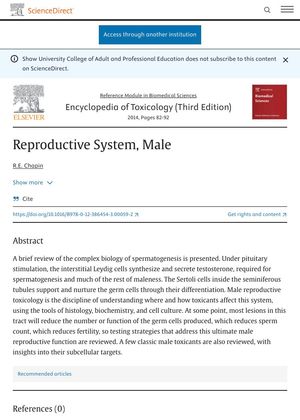Reproductive System, Male: Biology of Spermatogenesis and Toxicology
January 2014
in “
Elsevier eBooks
”

TLDR The document explains how sperm cells are produced, the role of testosterone in this process, and how toxins can reduce sperm count and fertility.
The document from 2013 provides a brief review of the complex biology of spermatogenesis, the process of sperm cell production. It explains that under pituitary stimulation, Leydig cells synthesize and secrete testosterone, which is necessary for spermatogenesis and much of male characteristics. Sertoli cells inside the seminiferous tubules support and nurture the germ cells during their differentiation. The document also discusses male reproductive toxicology, which is the study of how toxicants affect the male reproductive system. It mentions that most lesions in this tract will reduce the number or function of the germ cells produced, leading to a reduced sperm count and fertility. The document also reviews a few classic male toxicants and their subcellular targets.
